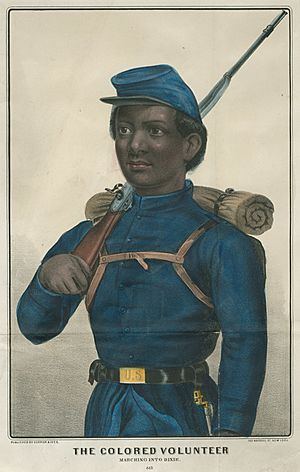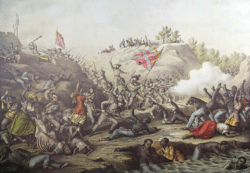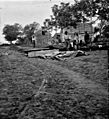African Americans in the American Civil War facts for kids
The American Civil War was a huge event in United States history. Many people, including over four million enslaved African Americans and about 500,000 free African Americans, lived in the country when the war started. They made up 14% of the population. Many African Americans played a big part in the war, especially as soldiers in the Union Army.
Contents
Why the War Started
Slavery began in the English colony of Jamestown, Virginia in 1619. At first, Africans were brought as indentured servants. This meant they worked for a period of time to pay off a debt. But soon, it became common for people to own slaves for their whole lives.
For many years, slaves worked on farms growing crops like tobacco. Later, after the cotton gin was invented in 1793, cotton became a very important crop. Slavery became a huge part of the South's economy.
As the country grew westward, people argued about whether new areas should allow slavery. This argument deeply divided the nation. The North had a growing industrial economy, while the South relied on farming and slavery. This big disagreement over slavery was a main reason the American Civil War began.
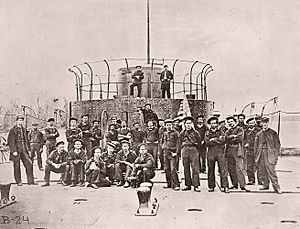
The United States Navy, called the Union Navy during the war, had different rules for African Americans. The United States Army did not allow black men to serve as soldiers until the war was two years old. But the Navy always allowed them to join.
In the 1840s, the Navy limited black sailors to 5% of its force. But before and after this time, black and white men often served together. When the war started, hundreds of black men were already in the Navy. After Fort Sumter was attacked, many more men joined. The number of black men in the Navy quickly grew. By the summer of 1862, about 15% of the sailors were African American.
Many black sailors came from the East Coast of the United States, especially Maryland and the Chesapeake Bay area. Many were already experienced sailors or worked in shipping.
African Americans fought in all the major naval battles of the Civil War. They served on ships blocking Southern ports and on riverboats. African American women also helped, mostly as nurses on the USS Red Rover (1859), a hospital ship on the Mississippi River. Eight African Americans in the Navy were given the Medal of Honor, the highest award for bravery.
Joining the Union Army
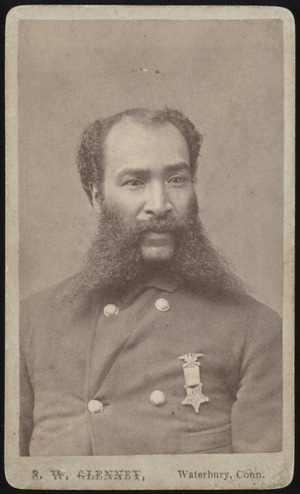
Once let the black man get upon his person the brass letter, U.S., let him get an eagle on his button, and a musket on his shoulder and bullets in his pocket, there is no power on earth that can deny that he has earned the right to citizenship—Frederick Douglass.
At first, President Abraham Lincoln worried about letting African Americans join the Army. He feared that if he armed them, especially former slaves, some states might leave the Union. This would make the war even harder. But after two years, the war was not going well for the North. Lincoln needed more soldiers, so he began to change his mind.
The Militia Act of 1862 allowed the Army to use African Americans as workers and soldiers. This was the first time since 1792. It led some black men to form their own private groups. For example, in New Orleans, three all-black units called the Louisiana Native Guard were formed. They later became official U.S. Colored Infantry regiments.
One of the most famous units was the 54th Massachusetts Infantry Regiment. In February 1863, the governor of Massachusetts asked for black soldiers. Over 1,000 men joined, some from as far away as Canada. A young white officer named Robert Gould Shaw led them. On July 18, 1863, the 54th attacked Fort Wagner in Charleston Harbor. They lost nearly half their men, including Colonel Shaw.
Pay and Treatment
Black soldiers in the Union Army did not get paid or treated the same as white soldiers. They earned $10 a month, but $3 was taken out for uniforms. White soldiers earned $13 a month with no uniform costs. In June 1864, Congress voted to give black soldiers equal pay.
Black units were kept separate from white units and were led by white officers. Some officers did not think black soldiers were good fighters and did not train them well.
Captured black Union soldiers were a big problem for the Confederacy. The Confederacy did not want to treat them like other prisoners. This would mean they accepted black soldiers as equals. It would also seem like they accepted Lincoln's Emancipation Proclamation, which they did not.
Jefferson Davis, the Confederate President, said that captured black slaves in uniform should be sent back to their states. The Confederate Congress even said that any black soldiers captured would be tried for "inciting servile insurrection" and could be put to death.
Lincoln said that all prisoners of war should be treated the same, no matter their skin color. He warned that if the Confederacy hurt any Union soldier, the Union would do the same to a Confederate soldier. This warning worked. No more black prisoners were executed or sent back into slavery. However, some Confederate commanders still refused to take black prisoners, shooting them instead. This happened at places like the Battle of Fort Pillow.
African Americans in the Confederate Forces
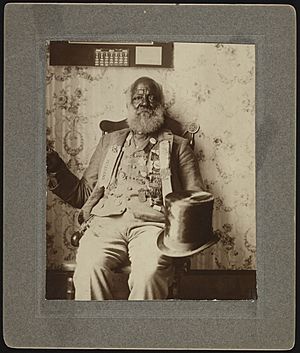
African Americans also served with the Confederacy, but mostly not as soldiers. Some went with their masters or worked as laborers behind the battle lines. They also worked as drivers and cooks. For most of the war, black men were not allowed to be soldiers in the Confederate army.
There are a few old photographs of African American men in Confederate uniforms. But these photos do not explain why they wore them. Four of these men were known slaves who went with their masters to the war.
Near the end of the war, the idea of using black soldiers was discussed. In 1864, General Patrick Cleburne suggested enlisting black slaves. Some Southern politicians were against it. One asked, "What did we go to war for, if not to protect our property?" Another said, "If slaves will make good soldiers, our whole theory of slavery is wrong."
General Robert E. Lee knew he needed more soldiers. He said, "We must decide whether slavery shall be extinguished by our enemies and the slaves be used against us, or use them ourselves." Lee suggested that slaves should be freed if they served as soldiers. But this condition was not included in the law passed by the Confederate Congress on March 13, 1865. Only a few thousand black men joined the Confederate army before the war ended. By that time, over 200,000 African Americans had served with the Union army.
Quick Facts About African Americans in the Civil War
- Slavery began in the United States in Jamestown, Virginia in 1619. It became a common practice in the South.
- Slavery was one of the main reasons the American Civil War started. The two sides were the Union (North) and the Confederates (South).
- The United States Navy, called the Union Navy during the war, always allowed black men to serve.
- After Fort Sumter was captured, more black men joined the Union Navy. By mid-1862, about 15% of the Navy were black men.
- Most African Americans who joined the Navy were from Maryland and the Chesapeake Bay area.
- African American women also served as nurses on the hospital ship USS Red Rover.
- At first, President Lincoln did not want to arm black men. But after two years of war, he changed his mind and allowed them to serve in the Union Army.
- The Militia Act of 1862 allowed the Army to use African Americans as workers and soldiers. They could form their own private groups.
- Black soldiers did not get the same pay or treatment as white soldiers. They earned less money, were in separate units, and were not always trained well.
- The Confederacy did not want to capture black Union soldiers. This would mean treating them as equals, which they did not want to do.
- Confederate forces used black men in the Civil War, but mostly as workers, not as soldiers.
- Robert E. Lee suggested that if slaves served as soldiers for the Confederacy, they should be given their freedom.
Images for kids
-
African-American laborers bury the dead at Fredericksburg, Virginia, 1862.
-
A lithograph of the storming of Fort Wagner.
-
Company I of the 36th Colored Regiment.U.S. Colored Troops, (USCT) Infantry.
-
Monument to U.S. Colored Troops at Vicksburg National Military Park


